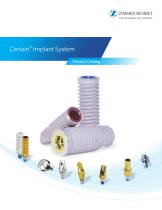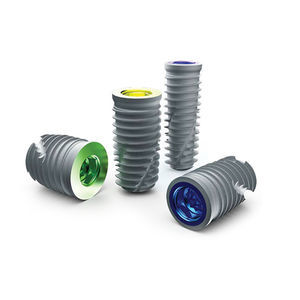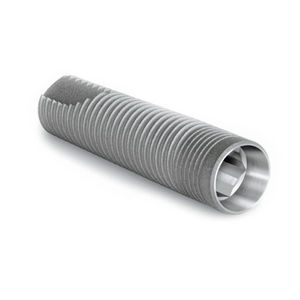
- Dental
- Dental practice
- Cylindrical dental implant
- Zimmer Dental

- Products
- Catalogs
- News & Trends
- Exhibitions
Cylindrical dental implant Osseotite®titaniuminternal hexagonexternal hexagon

Add to favorites
Compare this product
Characteristics
- Shape
- cylindrical
- Material
- titanium
- Connection
- internal hexagon, external hexagon
- Configuration
- straight
- Implant diameter
Max.: 6 mm
(0.24 in)Min.: 3.25 mm
(0.13 in)- Implant length
Max.: 20 mm
(0.79 in)Min.: 6.5 mm
(0.26 in)
Description
Characterized by a 1 to 3 micron peak-to-peak surface created by a unique acid-etch process, the Osseotite Surface features are precisely sized to entangle the fibrin strands of the blood clot.
Proven Clinical Success
The Osseotite Surface has more than 10 years of documentation from numerous global multi-center clinical studies1-6 and meta-analyses.
Clinical studies on the Osseotite Surface continue to document the benefits of increased contact osteogenesis, especially in poor-quality bone.
Characterized by a 1 to 3 micron peak-to-peak surface created by a unique acid-etch process, the Osseotite Surface features are precisely sized to entangle the fibrin strands of the blood clot.
Full Osseotite Dental Implants And Peri-Implantitis
A five-year prospective, multicenter, randomized-controlled study of the incidence of peri-implantitis for hybrid-DAE and fully-DAE implants.
Considerations for potential benefits of extending the DAE surface to the seating surface led to this prospective randomized-controlled study designed to assess the risk and incidence of peri-implantitis for fully-DAE-surfaced implants (Full Osseotite/FOSS).
Features & Benefits
Comprehensive Clinical Research
One of the Most Well-Researched Dental Implant Surfaces on the Market Today
Numerous Studies Report 98% Cumulative Success Rates
The Osseotite Surface
Demonstrates High Contact of Implant with New Bone
Human Histology with Demonstrated High Bone-To-Implant Contact9
VIDEO
Catalogs
Product_Catalog
40 Pages
Related Searches
- Implant abutment
- Titanium implant abutment
- Straight implant abutment
- Internal implant abutment
- Dental implant
- Titanium dental implant
- Hexagonal implant abutment
- Angulated implant abutment
- Internal hexagon implant abutment
- Screw implant abutment
- Bone substitute
- Tapered dental implant
- Dental implant analog
- Straight dental implant analog
- External implant abutment
- Hexagonal dental implant
- Cylindrical dental implant
- Impression cap
- Dental driver
- Internal hexagon dental implant
*Prices are pre-tax. They exclude delivery charges and customs duties and do not include additional charges for installation or activation options. Prices are indicative only and may vary by country, with changes to the cost of raw materials and exchange rates.






